Preserving watermelon until the New Year at home
Watermelon is a popular delicacy in the summer-autumn season, but what a highlight it will be on the holiday table in winter, and especially on New Year's holidays! However, it is not easy to preserve the berries in their original state for such a long period of time - you need to know how and where to store them.
We will tell you in this article how to properly preserve watermelon until the New Year at home.
Watermelon selection
Not every melon fruit is suitable for long-term storage. To choose the right fruit, it is important to consider a number of features:
- Watermelon retains its taste and beneficial properties for 3-4 months, so preference is given to late varieties that ripen at the beginning or end of September: for example, Ikar, Astrakhan, Volzhanin. Each of these varieties has sweet, juicy flesh and disease resistance. The fruit must ripen on its own, without growth-accelerating substances.
- Select only undamaged berries without cracks, dents, rot or scratches. For safe transportation, they are transported in boxes filled with straw. The stripes of the fruit should be bright and the color should be uniform. Medium-sized berries are most suitable.
- Signs of a correctly selected variety are dense pulp and thick peel.
- It is not advisable to buy goods in supermarkets and large chain stores. Store-bought watermelons, as a rule, are delivered for sale unripe, stuffed with chemical additives. The best option is to purchase from a trusted gardener.It is advisable to agree in advance so that the fruit is removed from the melon a couple of days ahead of schedule. This way, the likelihood of preserving the fruit longer will increase many times over.
Finding the best option the first time is not so easy, but later choosing the right watermelon will become a matter of habit.
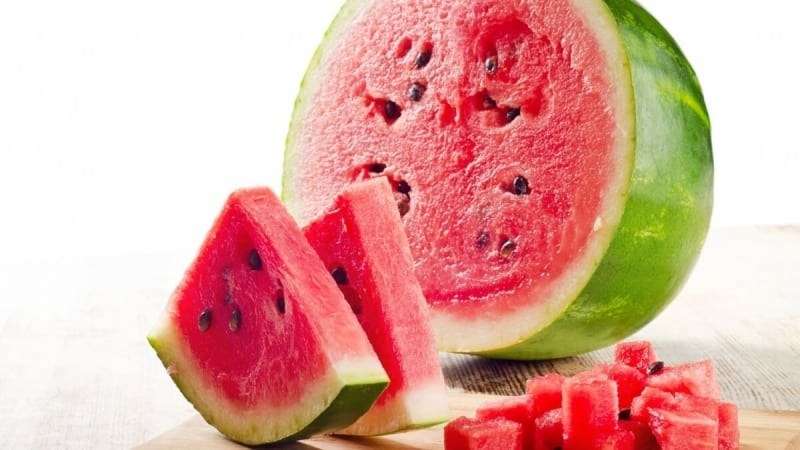
Basic principles of long-term storage
In creating optimal conditions for long-term maintenance of watermelons, everything is important: from room temperature to storage location. Experienced melon growers have identified a number of basic mandatory rules:
- Dehydration of the peel. It will be enough to leave the watermelons under the leaves for a day so that the excess moisture evaporates.
- Soft surface. Any manipulations with the fruit are done with soft gloves.
- Rack with straw - the best place for long-term storage of watermelons. They are isolated from each other.
- Temperature within +5…+8°C. Any increase in this norm will lead to souring of the berries.
- Humidity is maintained in the range of 60–80%. Failure to comply with the indicators will lead to loss of natural moisture of the fruit.
- Attention and care. Putting the fruits down and forgetting about them until the start of winter is not an option: they are regularly inspected and turned over to avoid stains and rotting.
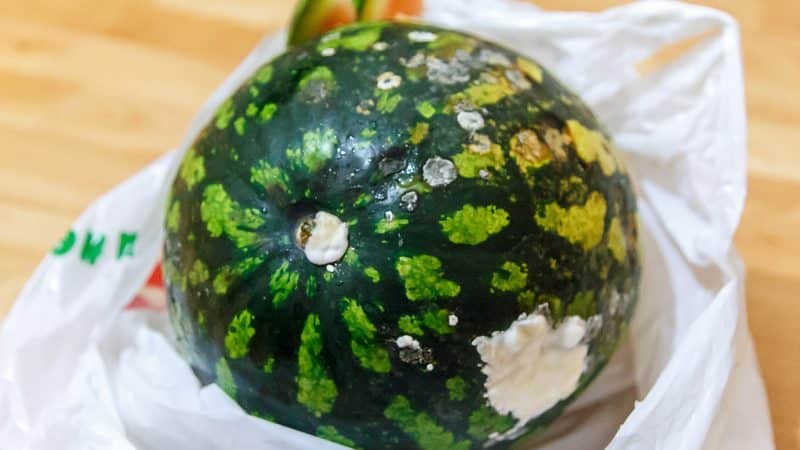
- Berries are extremely sensitive to any proximity, so they are stored separately from other crops. Particularly dangerous is the proximity to potatoes, which greatly reduces the shelf life of watermelons.
Fruits are stored both in an apartment and in your own home - each case has its own nuances.
In a private house
In such conditions it is convenient to keep large quantities of watermelons. The main advantage here is the large selection of storage locations. The most optimal:
- basement or cellar;
- attic;
- cool room or summer kitchen;
- pantry;
- garage.
The main condition: carefully monitor the humidity and temperature in the room.
In the apartment
You can also organize a crop storage area in your apartment if you find a dark and cool place. Most suitable for this:
- fridge;
- pantry;
- bathroom;
- glazed balcony;
- mezzanine;
- loggia.
If desired, for large berries in the apartment, allocate an area under the bed or windows.
Methods for storing watermelons at home
At home, without equipping a special place, it will not be possible to keep several watermelons in perfect condition at once.
At room temperature
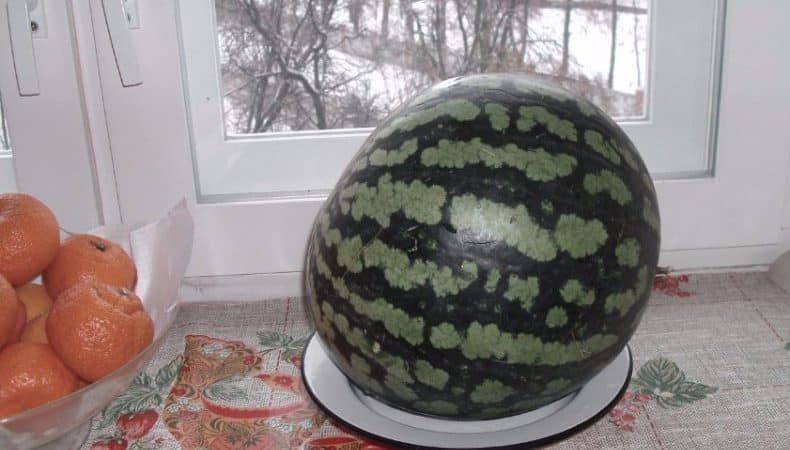
Such conditions will allow you to preserve the maximum amount of useful substances in the pulp: for example, beta-carotene and lycopene are retained by 20% more than in frozen fruits. However, the shelf life of the product at room temperature is reduced to 4-5 weeks.
In the cellar
Before placing watermelons in the cellar, it is important to make sure that the temperature and humidity meet the standards. If the parameters turn out to be stable throughout the entire period, then the shelf life of the berries will be 10–12 months.
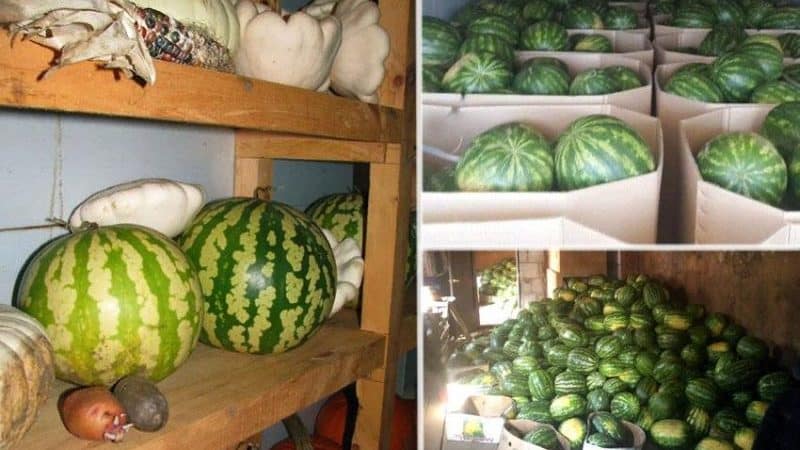
In a refrigerator
The main thing in long-term storage is maintaining a stable temperature. In this regard, the most suitable place is the refrigerator. The fruits are placed on the middle or lower shelf, on dense soft fabric.
The disadvantage of this method is the extremely limited space. You can place no more than 1-2 watermelons in the refrigerator. This option is suitable for a period of no more than 2-3 months.
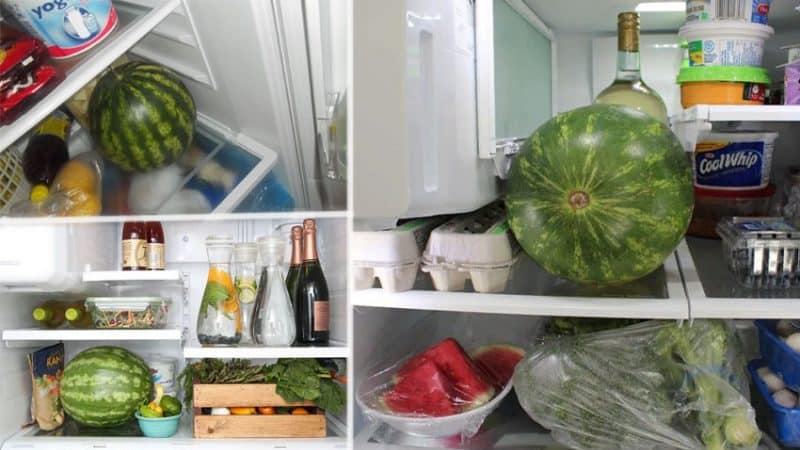
In the freezer
How to store watermelons in the freezer? To do this, they are cut into slices. The pulp reacts poorly to prolonged exposure to strong low temperatures: after thawing, it loses its original structure and a significant part of its nutrients.Therefore, the defrosted product is used to create drinks.
Blanks
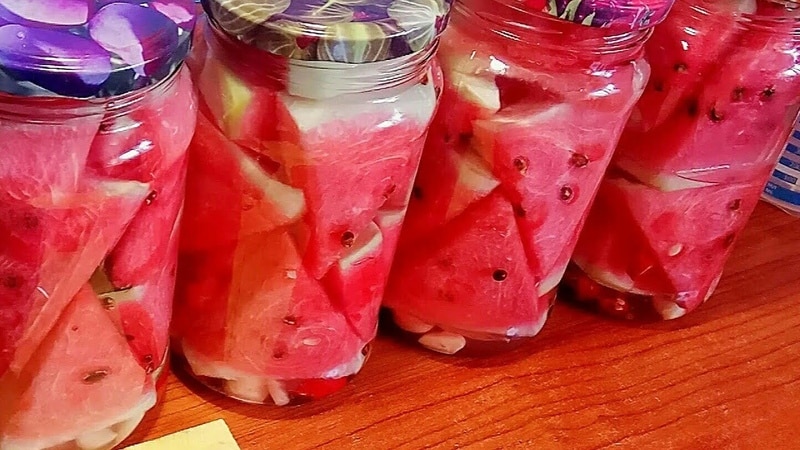
In the form of watermelon blanks will last until next summer. It will lose its original juiciness, but will acquire piquancy and new flavor notes.
Interesting! If there are a lot of fruits, they are fermented in barrels, like apples. For this purpose, choose berries of the same size weighing about 2 kg.
Another way - preservation in a jar. This preparation will not only look exotic, but will also delight you with its taste. However, you will have to forget about the initial beneficial properties of the fruit.
Other storage options
In addition to the basic ones, there are additional, sometimes unusual ways to store watermelons.
Wax wrap
For this method, paraffin or wax is melted and then applied in several layers to the fruit. The thickness of the coating is no more than 1 cm. Such fruits are kept in a cool room.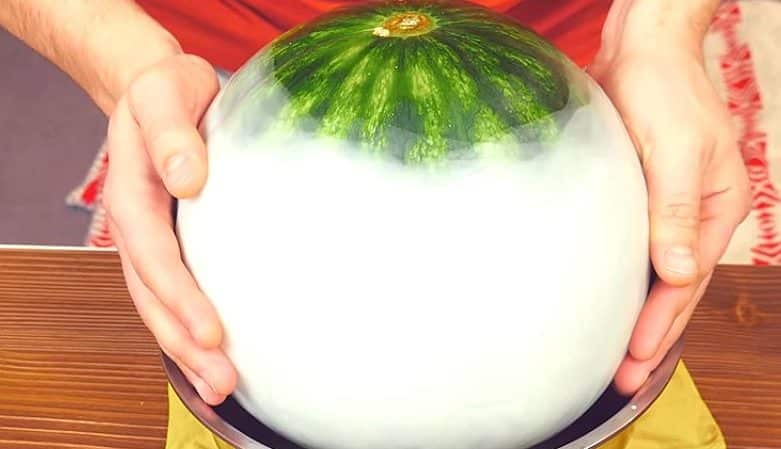
In clay
Clay has adsorption and disinfectant properties and protects watermelon from fungus and dampness. The dense crust protects the fruits from any impact.
The clay is diluted in warm water (the container should not be metal), mixed and applied to the berry in a thick layer. When the crust has completely hardened, the watermelon is put in a cool, dark place.
In sand or grain
With this method, the fruits are placed in a previously prepared wooden box, which is covered with sand. It is not worth compacting too much, so as not to block the air supply. Another option is dry grains without signs of pests.
In the straw
Clean straw is a great way to protect your watermelon. It is both folded into a box and placed on a shelf. Straw can be easily replaced with the ash of deciduous trees, dry tow or dried moss.However, rodents and insects love to be in these materials, so they carefully monitor the area.
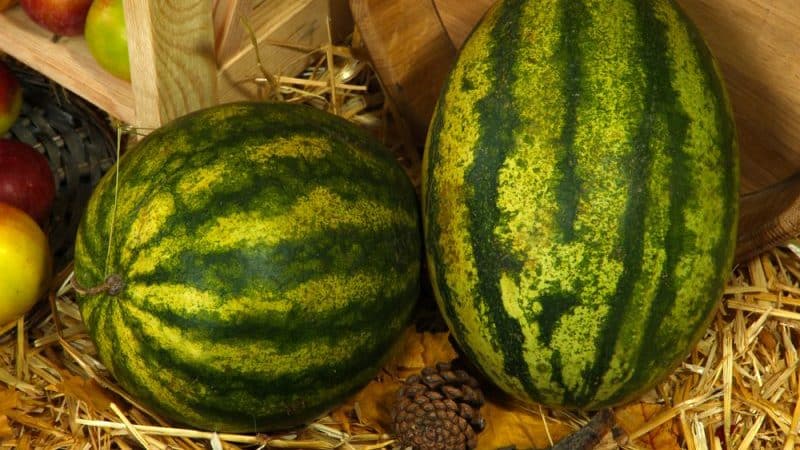
Hanging
The fruit is wrapped in natural fabric or old newspapers and hung in a net, canvas bag or string bag. This method will provide the watermelon with air access and uniform temperature and humidity conditions. This option is suitable for large apartments and private houses.
In water
A rather unusual option, in which cold water is used to completely cover the fruit. A good solution would be to store the watermelon in a prepared ice hole or wooden vat. The liquid is changed 2-3 times, do not allow freezing.
How long do watermelons last?
If the fruits were carefully selected and kept according to all the rules, then their shelf life increases until spring. On average, the duration is 3-4 months.
All storage methods are also suitable for other melons: melons, pumpkins.
Tips and common mistakes
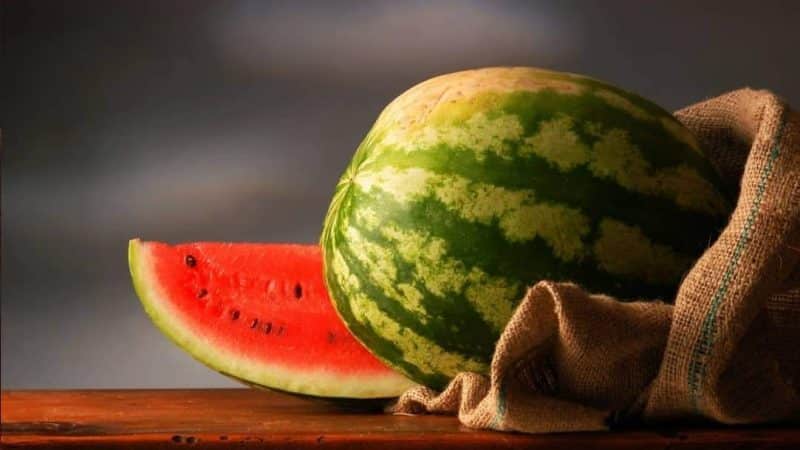
If it was not possible to save watermelons for a long time, the main reason for this is non-compliance with recommendations. Ignoring or partially following even one piece of advice leads to damage to the product. The most common errors and problems:
- choosing the wrong fruits;
- violation of humidity levels;
- lack of periodic care and inspection;
- temperature fluctuations;
- pests and parasites.
That is why careful preparation and thorough study of the issue are so important. Tips for improving the storage of melons:
- Watermelons are chosen completely ripeso that they do not ripen after harvest and are not subject to early spoilage. The taste of unripe berries leaves much to be desired.
- Fruits should not come into contact with other crops or with each other. The contact points quickly begin to rot.
- Use only soft bedding (grain, hay, sawdust).Placing a watermelon on a hard surface is a sure way to ruin it ahead of time.
- Periodically, the fruits are turned over and checked for integrity. Do this with soft gloves so as not to damage the berries.
Upon examination, signs of rot and fungi are revealed. If any fruit has become noticeably lighter than the others, it is removed.
Read also:
How to save watermelon seeds for planting at home.
Step-by-step instructions: how to dry watermelon in an electric dryer.
Watermelon guards male power: how it is beneficial for the body.
Conclusion
Long-term storage of watermelons is not an easy process. Before starting, carefully study all the recommendations and advice, without deviating from any of them. They painstakingly approach each stage: choosing fruits, organizing the place, planning care. Then in winter you will be able not only to taste the juicy delicacy yourself, but also to surprise your guests with it.